Subsurface Temperature Properties for Three Types of Permeable Pavements in Cold Weather Climates and Implications for Deicer Reduction
Abstract
:1. Introduction
2. Materials and Methods
2.1. Site Description
2.2. Temperature Data Collection
2.3. Statistical Evaluation
3. Results
3.1. Daily Temperatures
3.2. Freeze/Thaw: Lag Time
4. Discussion
5. Conclusions
Author Contributions
Funding
Data Availability Statement
Acknowledgments
Conflicts of Interest
References
- Burns, M.J.; Fletcher, T.D.; Walsh, C.J. Hydrologic shortcomings of conventional urban stormwater management and opportunities for reform. Landsc. Urban Plan. 2012, 105, 230–240. [Google Scholar] [CrossRef]
- Drake, J.; Bradford, A.; Van Seters, T. Stormwater quality of spring-summer-fall effluent from three partial-infiltration permeable pavement systems and conventional asphalt pavement. J. Environ. Manag. 2014, 139, 69–79. [Google Scholar] [CrossRef]
- Li, H.; Harvey, J.T.; Holland, T.J.; Kayhanian, M. The use of reflective and permeable pavements as a potential practice for heat island mitigation and stormwater management. Environ. Res. Lett. 2013, 8, 015023. [Google Scholar] [CrossRef]
- Li, H.; Jones, D.; Wu, R.; Harvey, J.T. Development and HVS Validation of Design Tables for Permeable Interlocking Concrete Pavement: Final Report. University of California Pavement Research Center, Davis, Ca., UCPRC-RR-2014-04.2. 2014. Available online: http://www.ucprc.ucdavis.edu/PDF/UCPRC-RR-2014-04.pdf (accessed on 6 December 2021).
- Bethany, E.; Lindow, K.C.; Smith, D.R. (Eds.) Permeable Pavements: Reston, Va; American Society of Civil Engineers: Reston, VA, USA, 2015; p. 249. [Google Scholar] [CrossRef]
- Roseen, R.M.; Ballestero, T.P.; Houle, J.J.; Briggs, J.F.; Houle, K.M. Water quality and hydrologic performance of a porous asphalt pavement as a storm-water treatment strategy in a cold climate. J. Environ. Eng. 2012, 138, 81–89. [Google Scholar] [CrossRef]
- Roseen, R.M.; Houle, J.; Ballestero, T.P.; Puls, T. Pre-Construction, Construction, and Post-Construction Monitoring Report for Greenland Meadows for July 2007–October 2010; Durham, N.H., Ed.; The University of New Hampshire Stormwater Center: Durham, NH, USA, 2010; p. 15. Available online: https://www.unh.edu/unhsc/sites/unh.edu.unhsc/files/docs/2010%20UNH%20SC_Packard%20Monitoring%20interim%20report_final.b.pdf (accessed on 5 January 2018).
- Sansalone, J.; Kuang, X.; Ying, G.; Ranieri, V. Filtration and clogging of permeable pavement loaded by urban drainage. Water Res. 2012, 46, 6763–6774. [Google Scholar] [CrossRef]
- Gilbert, J.K.; Clausen, J.C. Stormwater runoff quality and quantity from asphalt, paver, and crushed stone driveways in Connecticut. Water Res. 2006, 40, 826–832. [Google Scholar] [CrossRef]
- Fassman, E.A.; Blackbourn, S. Urban runoff mitigation by a permeable pavement system over impermeable soils. J. Hydrol. Eng. 2010, 15, 475–485. [Google Scholar] [CrossRef]
- Brattebo, B.O.; Booth, D.B. Long-term stormwater quantity and quality performance of permeable pavement systems. Water Res. 2003, 37, 4369–4376. [Google Scholar] [CrossRef]
- Winston, R.J.; Al-Rubaei, A.M.; Blecken, G.T.; Viklander, M.; Hunt, W.F. Maintenance measures for preservation and recovery of permeable pavement surface infiltration rate—The effects of street sweeping, vacuum cleaning, high pressure washing, and milling. J. Environ. Manag. 2016, 169, 132–144. [Google Scholar] [CrossRef]
- Balades, J.D.; Legret, M.; Madiec, H. Permeable pavements—Pollution management tools. Water Sci. Technol. 1995, 32, 49–56. [Google Scholar] [CrossRef]
- Brown, C.; Chu, A.; van Duin, B.; Valeo, C. Characteristics of sediment removal in two types of permeable pavement. Water Qual. Res. J. Can. 2009, 44, 59–70. Available online: https://citeseerx.ist.psu.edu/viewdoc/download?doi=10.1.1.1058.9456&rep=rep1&type=pdf (accessed on 22 August 2021). [CrossRef] [Green Version]
- Lucke, T.; Beecham, S. Field investigation of clogging in a permeable pavement system. Build. Res. Inf. 2011, 39, 603–615. [Google Scholar] [CrossRef]
- Tirpak, A.; Winston, R.J.; Feliciano, M.; Dorsey, J.D. Stormwater quality performance of permeable interlocking concrete pavement receiving run-on from an asphalt traffic lane in a cold climate. Environ. Sci. Pollut. Res. 2020, 27, 21716–21732. [Google Scholar] [CrossRef] [PubMed]
- Selbig, W.R.; Buer, N. Hydraulic, Water-Quality, and Temperature Performance of Three Types of Permeable Pavement under High Sediment Loading Conditions; Scientific Investigations Report 2018–5037; U.S. Geological Survey: Reston, VA, USA, 2018; Volume 44. [Google Scholar]
- Selbig, W.R.; Buer, N.; Danz, M.E. Stormwater-quality performance of lined permeable pavement systems. J. Environ. Manag. 2019, 251, 13. [Google Scholar] [CrossRef]
- Drake, J.; Marvin, J.; Scott, J. De-icing Operations for Permeable Interlocking Concrete Pavements, Interlocking Concrete Pavement Institute Foundation for Education and Research. 2020, p. 58. Available online: https://www.researchgate.net/publication/340950433_De-icing_Operations_for_Permeable_Interlocking_Concrete_Pavements (accessed on 24 August 2021).
- U.S. Environmental Protection Agency. National Recommended Water Quality Criteria—Aquatic Life Criteria Table. 2012. Available online: https://www.epa.gov/wqc/national-recommended-water-quality-criteria-aquatic-life-criteria-table (accessed on 27 April 2021).
- Kevern, J.T.; Schaefer, V.R.; Wang, K. Temperature behavior of pervious concrete systems. J. Transp. Res. Board 2009, 2098, 94–101. [Google Scholar] [CrossRef]
- Wenck Associates, Inc. Porous Pavement Paired Intersection Study; Wenck Associates: Maple Plain, MN, USA, 2014; Available online: http://www.shinglecreek.org/uploads/5/7/7/6/57762663/paired_intersection_study_final_report.pdf (accessed on 23 September 2021).
- Zhang, K.; Kevern, J. Review of porous asphalt pavements in cold regions: The state of practice and case study repository in design, construction, and maintenance. J. Infrastruct. Preserv. Resil. 2021, 2, 1–17. [Google Scholar] [CrossRef]
- Weiss, P.T.; Kayhanian, M.; Khazanovich, L.; Gulliver, J.S. Permeable Pavements in Cold Climates: State of the Art and Cold Climate Case Studies, Minnesota Department of Transportation, MN/RC 2015-30. 2015, p. 375. Available online: https://www.lrrb.org/pdf/201530.pdf (accessed on 5 November 2021).
- Houle, K.M.; Roseen, R.M.; Ballestero, T.P.; Briggs, J.F.; Houle, J.J. Examinations of pervious concrete and porous asphalt pavements performance for stormwater management in northern climates. In Proceedings of the Low Impact Development International Conference, San Francisco, CA, USA, 17–21 May 2010; World Environmental and Water Resources Congress: Kansas City, MO, USA, 2009. Available online: http://ascelibrary.org/doi/abs/10.1061/41099%28367%29111 (accessed on 25 August 2021).
- Smith, D.R. Permeable Interlocking Concrete Pavements, 5th ed.; Interlocking Concrete Pavement Institute: Chantilly, VA, USA, 2017. [Google Scholar]
- Erickson, A.J.; Gulliver, J.S.; Herb, W.R.; Janke, B.D.; Nguyen, N.K. Permeable Pavement for Road Salt Reduction, Minnesota Department of Transportation, MN 2020-15. 2020, p. 155. Available online: https://www.dot.state.mn.us/research/reports/2020/202015.pdf (accessed on 24 August 2021).
- Backstrom, M.; Bergstrom, A. Draining function of porous asphalt during snowmelt and temporary freezing. Can. J. Civ. Eng. 2000, 27, 594–598. [Google Scholar] [CrossRef]
- Drake, J.A.P.; Bradford, A.; Marsalek, J. Review of environmental performance of permeable pavement systems: State of the knowledge. Water Qual. Res. J. Can. 2013, 48, 203–222. [Google Scholar] [CrossRef]
- Omega Engineering Inc. Wire Color Codes and Limits of Error. 2019. Available online: https://www.omega.com/en-us/colorcodes (accessed on 16 November 2021).
- Danz, M.E.; Buer, N.H.; Selbig, W.R. Cold-Weather Air and Subsurface Temperature Profiles of Three Different Permeable Pavements, Madison, Wisconsin (2014–2021). U.S. Geological Survey Data Release; 2021. Available online: https://www.sciencebase.gov/catalog/item/61a93820d34eb622f699a7ad (accessed on 6 December 2021).
- NOAA/NCDC. Local Climatological Data Station Details: Madison Dane Co Regional Airport, WI US, Subset Used: November 2014–April 2021. 2021. Available online: https://www.ncdc.noaa.gov/cdo-web/datasets/LCD/stations/WBAN:14837/detail (accessed on 3 May 2021).
- Backstrom, A. Ground temperature in porous pavement during freezing and thawing. J. Transp. Eng. 2000, 126, 375–381. [Google Scholar] [CrossRef]
- Cambridge Systematics, Inc. Cool Pavement Report: EPA Cool Pavements Study-Task 5 (pdf); Draft Report; Environmental Protection Agency: Washington, DC, USA, 2005; Available online: https://citeseerx.ist.psu.edu/viewdoc/download?doi=10.1.1.648.3147&rep=rep1&type=pdf (accessed on 2 September 2021).
- Pitt, R.; Clark, S.; Field, R. Groundwater contamination potential from stormwater infiltration practices. Urban Water 1999, 1, 217–236. [Google Scholar] [CrossRef]
- Wilde, F.D. Geochemistry and Factors Affecting Ground-Water Quality at Three Storm-Water-Management Sites in Maryland: Report of investigations No. 59; Prepared in Cooperation with the U.S. Department of the Interior Geological Survey, The Maryland Department of the Environment, and The Governor’s Commission on Chesapeake Bay Initiatives; Department of Natural Resources, Maryland Geological Survey: Baltimore, MD, USA, 1994; 201p. Available online: http://www.mgs.md.gov/publications/report_pages/RI_59.html (accessed on 1 September 2021).
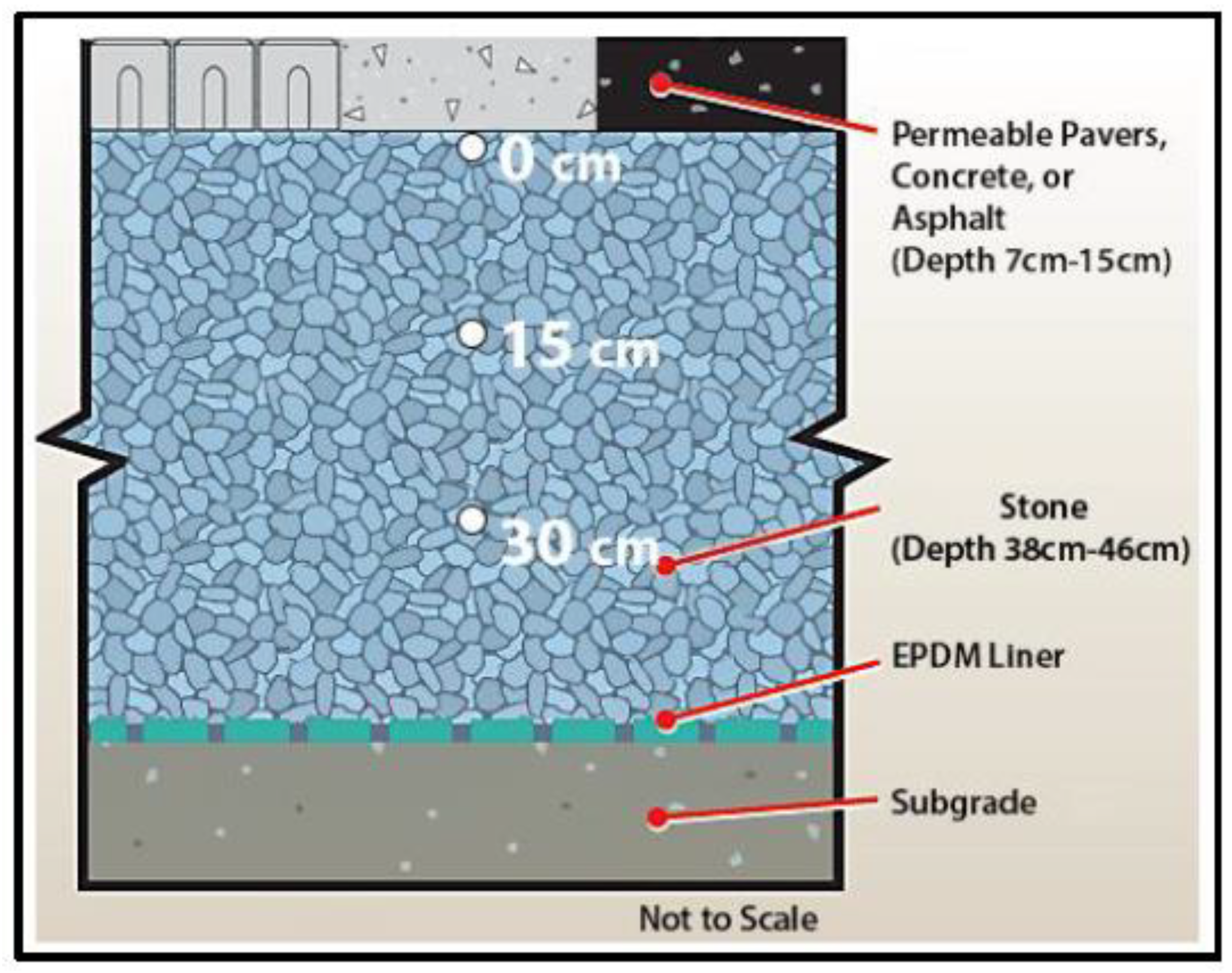
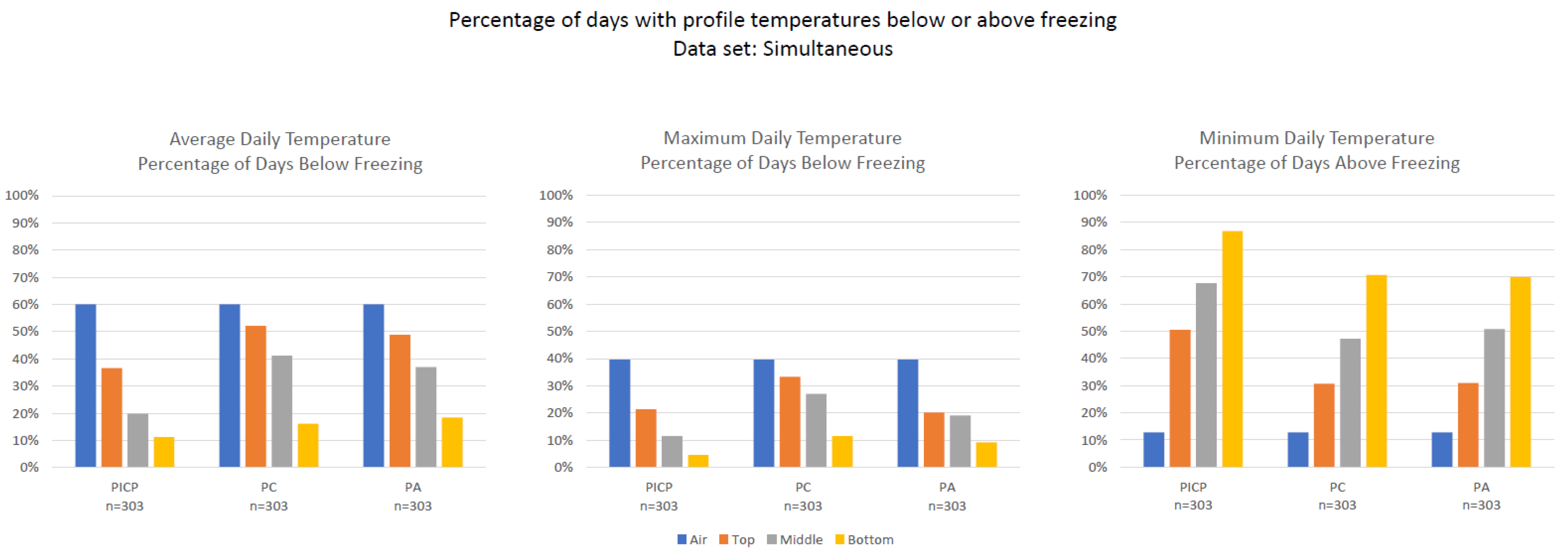
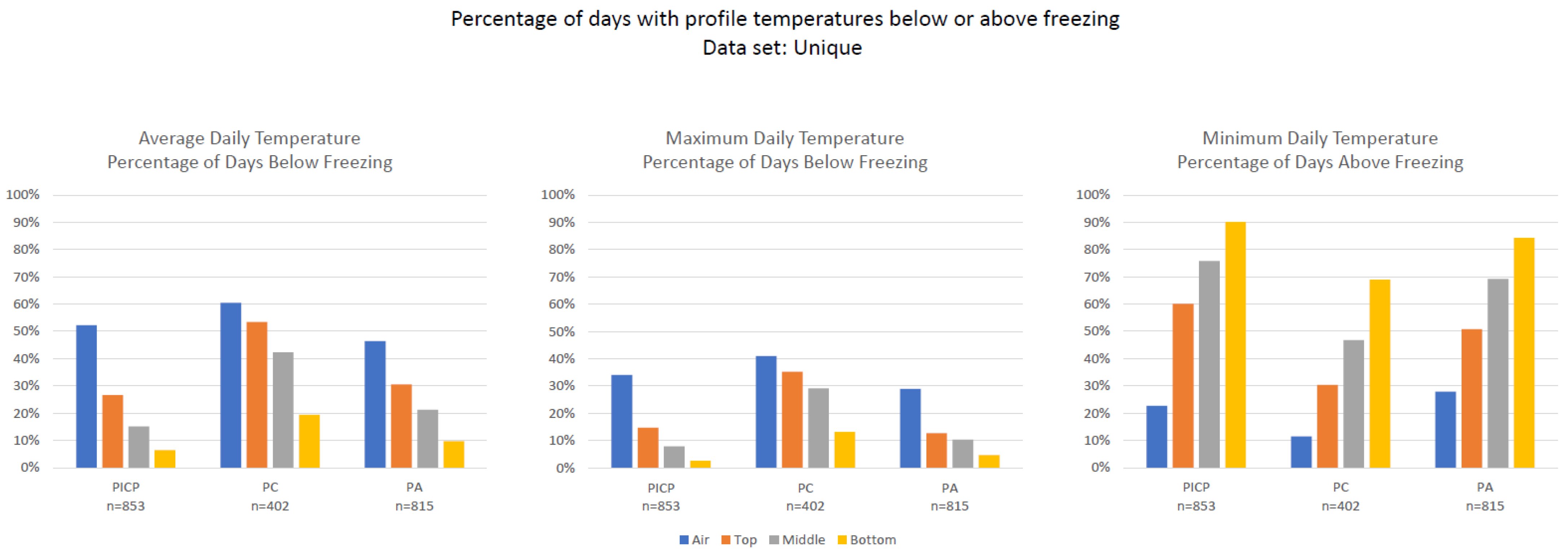
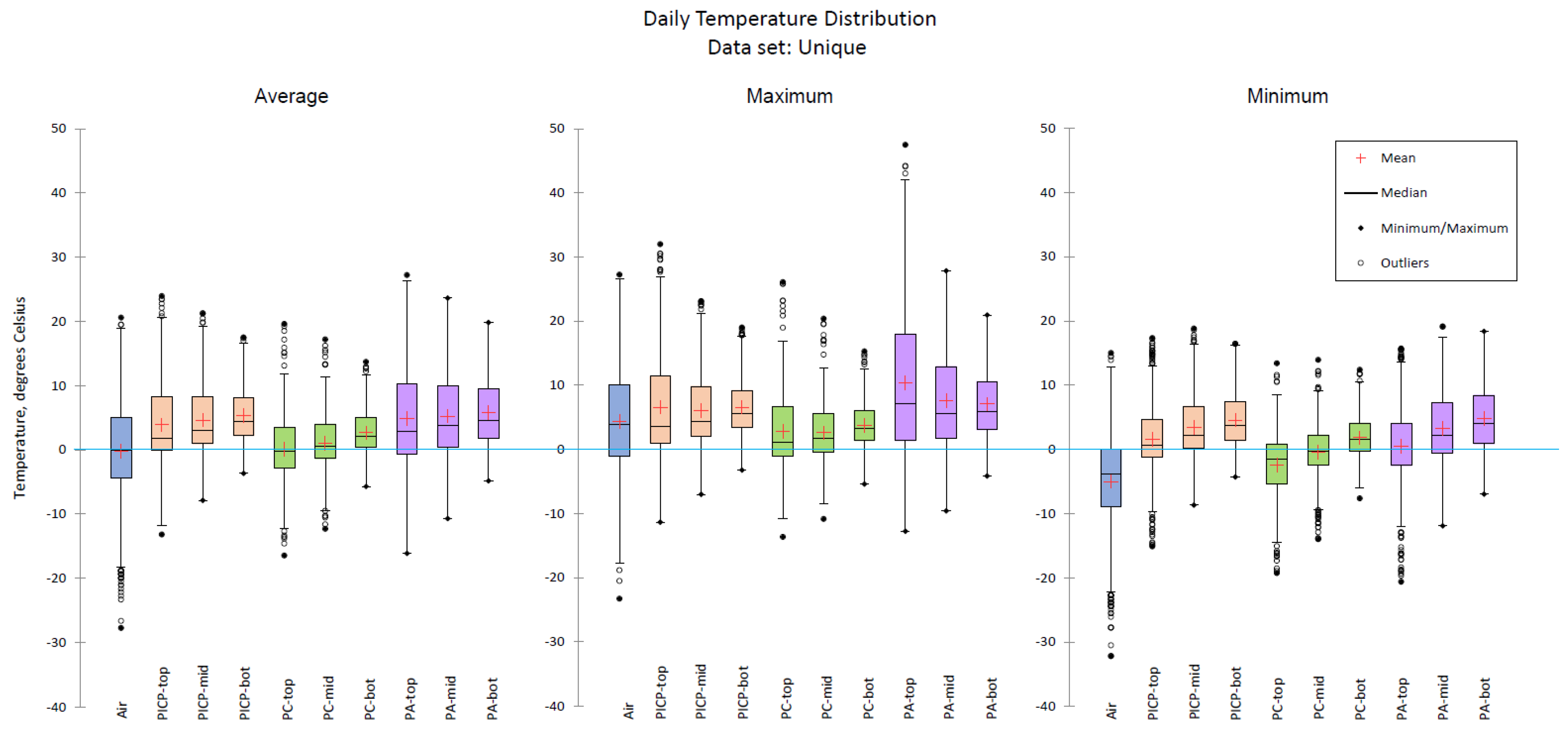
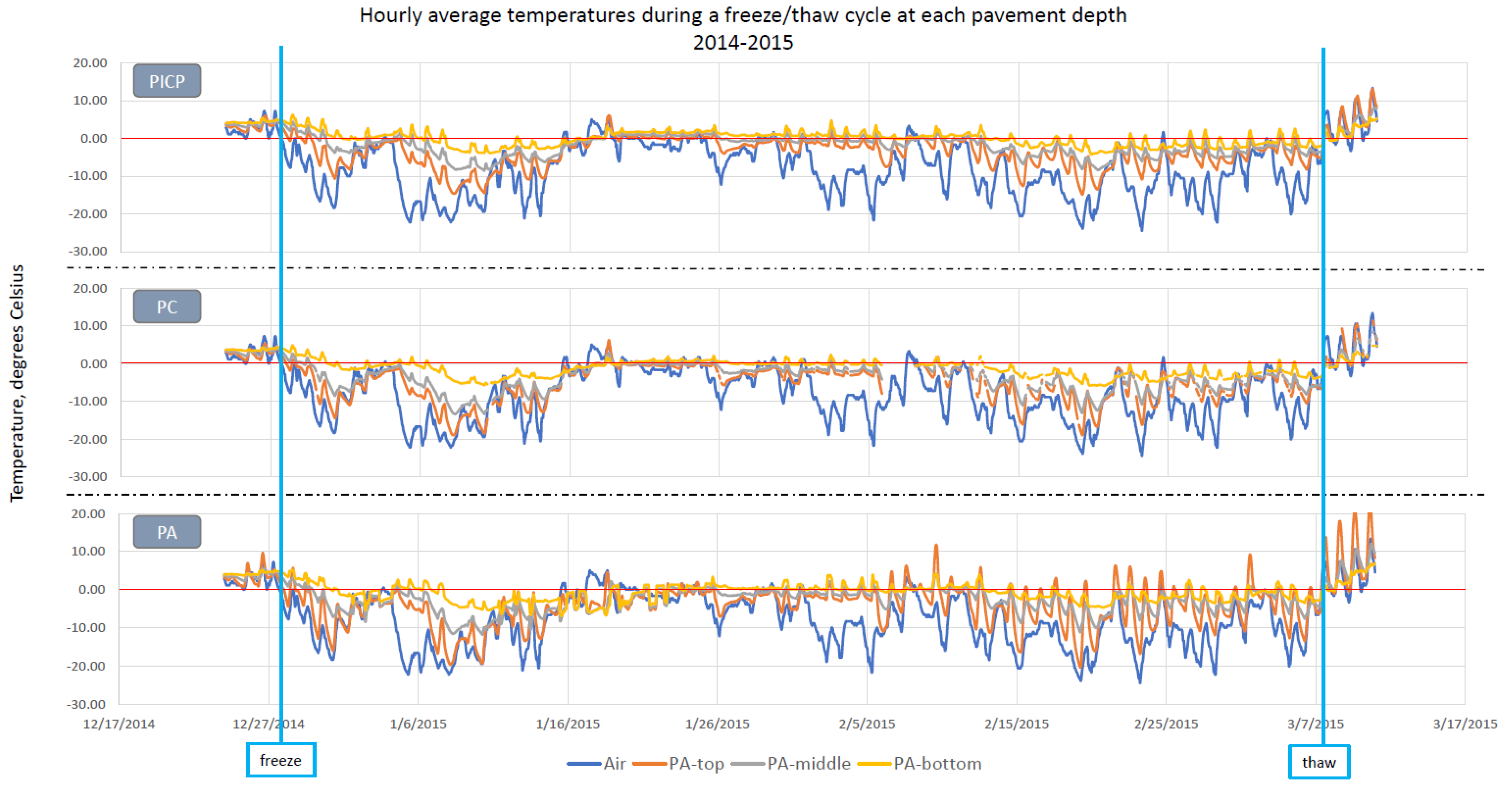
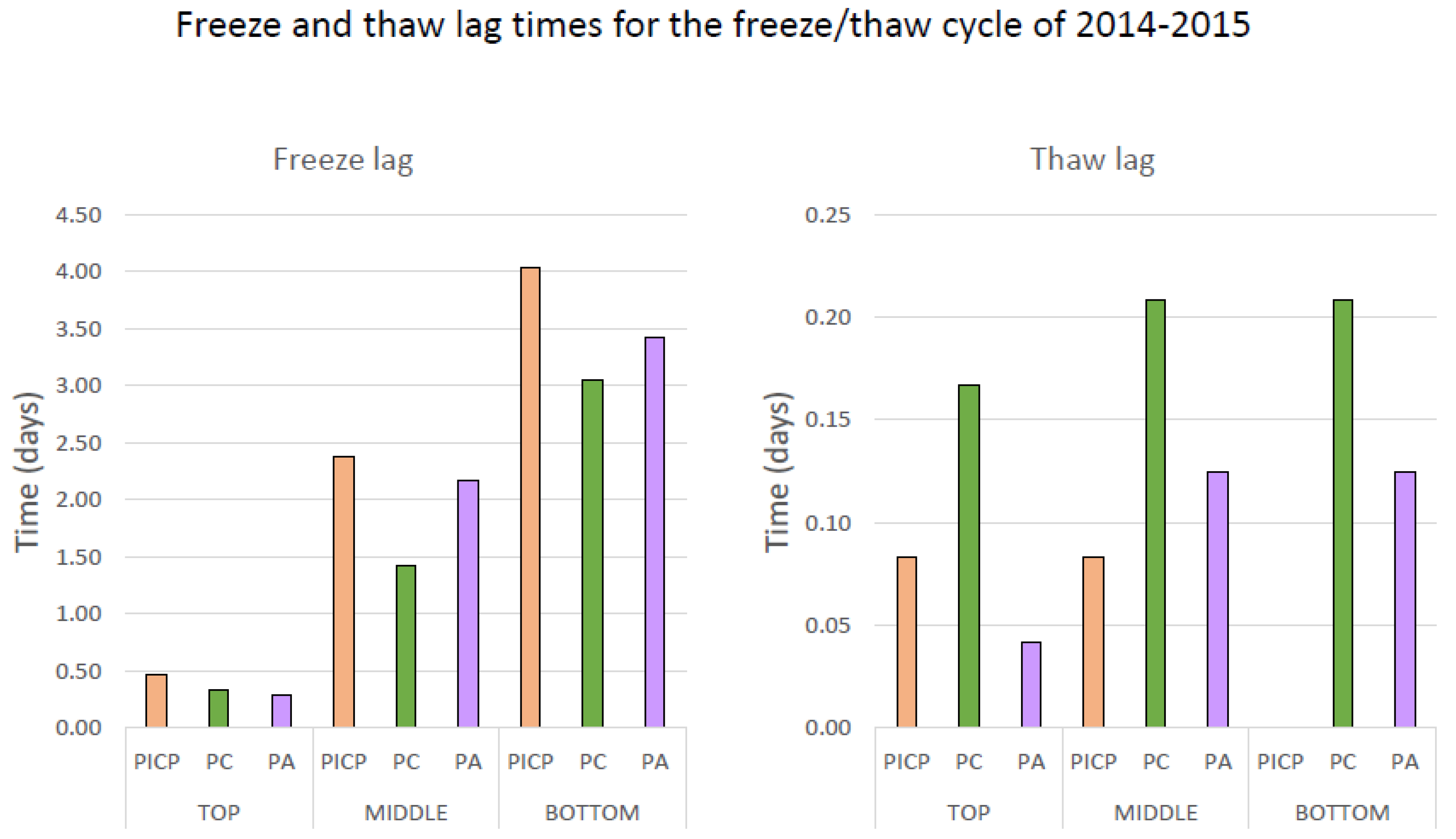
| Dataset | Surface Type | Average Temperature below Freezing | Maximum Temperature below Freezing | Minimum Temperature above Freezing | |||||||||
|---|---|---|---|---|---|---|---|---|---|---|---|---|---|
| Air | Top | Middle | Bottom | Air | Top | Middle | Bottom | Air | Top | Middle | Bottom | ||
| Simultaneous Dataset (Days) | PICP (n = 303) | 182 | 111 | 60 | 34 | 120 | 65 | 35 | 14 | 39 | 153 | 205 | 263 |
| PC (n = 303) | 182 | 158 | 125 | 49 | 120 | 101 | 82 | 35 | 39 | 93 | 143 | 214 | |
| PA (n = 303) | 182 | 148 | 112 | 56 | 120 | 61 | 58 | 28 | 39 | 94 | 154 | 212 | |
| Unique Dataset (Days) | PICP (n = 853) | 446 | 227 | 129 | 55 | 291 | 126 | 67 | 22 | 194 | 513 | 647 | 769 |
| PC (n = 402) | 243 | 215 | 170 | 78 | 165 | 142 | 117 | 53 | 46 | 122 | 188 | 277 | |
| PA (n = 815) | 378 | 249 | 173 | 79 | 236 | 104 | 85 | 38 | 227 | 414 | 564 | 687 | |
| Date | Lag | Top | Middle | Bottom | ||||||
|---|---|---|---|---|---|---|---|---|---|---|
| PICP | PC | PA | PICP | PC | PA | PICP | PC | PA | ||
| 2014 | Freeze Lag (Days) | 0.46 | 0.33 | 0.29 | 2.38 | 1.42 | 2.17 | 4.04 | 3.04 | 3.42 |
| Thaw Lag (Days) | 0.08 | 0.17 | 0.04 | 0.08 | 0.21 | 0.13 | <0.01 | 0.21 | 0.13 | |
| 2019 A | Freeze Lag (Days) | 0.58 | 0.33 | 0.25 | 1.54 | 1 | 1.13 | DNF | 8.46 | 3.79 |
| Thaw Lag (Days) | 0.96 | 1.92 | 2.08 | 0.88 | 1.92 | 3.17 | DNF | 0.88 | 3.21 | |
| 2019 B | Freeze Lag (Days) | 1.71 | 0.67 | 0.29 | 3.92 | 1.04 | 0.29 | DNF | 4.63 | 0.29 |
| Thaw Lag (Days) | TBA | 0.79 | 0.71 | TBA | 0.75 | TBA | DNF | TBA | DNF | |
Publisher’s Note: MDPI stays neutral with regard to jurisdictional claims in published maps and institutional affiliations. |
© 2021 by the authors. Licensee MDPI, Basel, Switzerland. This article is an open access article distributed under the terms and conditions of the Creative Commons Attribution (CC BY) license (https://creativecommons.org/licenses/by/4.0/).
Share and Cite
Danz, M.E.; Buer, N.H.; Selbig, W.R. Subsurface Temperature Properties for Three Types of Permeable Pavements in Cold Weather Climates and Implications for Deicer Reduction. Water 2021, 13, 3513. https://doi.org/10.3390/w13243513
Danz ME, Buer NH, Selbig WR. Subsurface Temperature Properties for Three Types of Permeable Pavements in Cold Weather Climates and Implications for Deicer Reduction. Water. 2021; 13(24):3513. https://doi.org/10.3390/w13243513
Chicago/Turabian StyleDanz, Mari E., Nicolas H. Buer, and William R. Selbig. 2021. "Subsurface Temperature Properties for Three Types of Permeable Pavements in Cold Weather Climates and Implications for Deicer Reduction" Water 13, no. 24: 3513. https://doi.org/10.3390/w13243513
APA StyleDanz, M. E., Buer, N. H., & Selbig, W. R. (2021). Subsurface Temperature Properties for Three Types of Permeable Pavements in Cold Weather Climates and Implications for Deicer Reduction. Water, 13(24), 3513. https://doi.org/10.3390/w13243513






